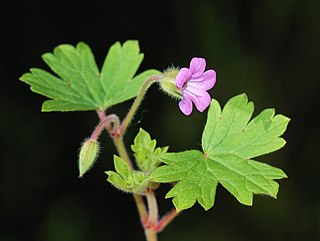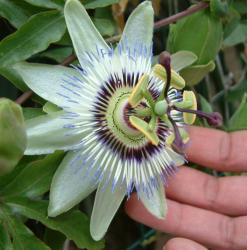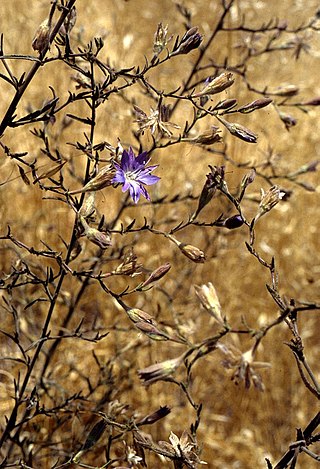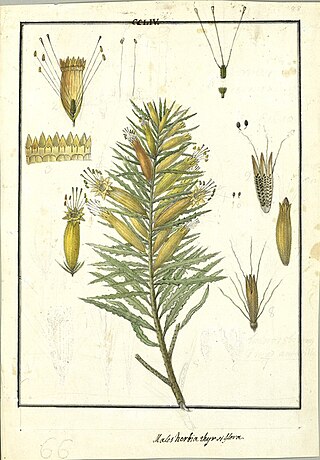
Geraniaceae is a family of flowering plants placed in the order Geraniales. The family name is derived from the genus Geranium. The family includes both the genus Geranium and the garden plants called geraniums, which modern botany classifies as genus Pelargonium, along with other related genera.

Ribes is a genus of about 200 known species of flowering plants, most of them native to the temperate regions of the Northern Hemisphere. The various species are known as currants or gooseberries, and some are cultivated for their edible fruit or as ornamental plants. Ribes is the only genus in the family Grossulariaceae.

The Passifloraceae are a family of flowering plants, containing about 750 species classified in around 27 genera.

Malesherbia is a genus of flowering plants consisting of 25 species in the Passifloraceae. This is a xerophytic group endemic to the Peruvian and Chilean deserts and adjacent Argentina. The genus is currently recognized by the APG III system of classification in the family Passifloraceae, and is the sole member of the subfamily Malesherbioideae.

Codon is a small genus of plants from South Africa in the family Codonaceae in the order Boraginales. The genus Codon comprises two species.

Malesherbia angustisecta is an endangered member of Malesherbia (Passifloraceae). It is colloquially called clavelina. The first published description of the species dates to 1922 and Hermann Harms is accredited with its discovery. It is native to arid and semiarid deserts of Peru. It is a pale green woody shrub and has pale pink / white flowers.

Malesherbia ardens, a member of Malesherbia (Passifloraceae), is a shrub with red flowers, native to the arid deserts of Southern Peru, though it can be found in the northern regions of the country. It is colloquially called Lampaya. The oldest known record of M. ardens dates 1927 in the 4th volume of the Field Columbian Museums' Botanical series. James Francis Macbride is accredited with its discovery.

Malesherbia arequipensis is a herbaceous member of Malesherbia (Passifloraceae) with white flowers. It first described in 1961 by botanist Mario H. Ricardi Salinas and is native to Arequipa and Moquegua. It is the only member of Malesherbia that grows outside of the Andes. It grows up to 15 cm tall and has white flowers.

Malesherbia auristipulata is a perennial woody shrub in the genus Malesherbia (Passifloraceae). Locally it is called Ají de Zorra. M. auristipulata is commonly found in Northern Chili and rarely in Tacna, Peru. In general, the species range is very restricted as a result M. auristipulata is considered a rare plant. It is likely that there are less than 100 individuals left, classifying the species as critically endangered by the local government.
Malesherbia deserticola is a subshrub native to the deserts and dry shrublands of Antofagasta and Atacama Chile. It can reach heights of 40 cm and has white racemose flowers.
Malesherbia fatimae is a shrub native to Chuquibamba, Peru. It phenotypically differs greatly from other Peruvian members of Malesherbia in terms of leaves and branch formation and density. It flowers all year long and has dense racemes red flowers.

Malesherbia humilis is an annual herb that grows in the subtropics of northern and central Chile to Argentina.

Malesherbia linearifolia is a subshrub native to the Coquimbo, Valparaiso, Metropolitana, and O'Higgins regions of Chile. It was the first member of Malesherbia to be described, with the original description dating to 1797 by Cavanilles.
Malesherbia lirana is a perennial herb whose native range is from Argentina and Chile. The species has racemose inflorescences that are 2 - 3.9 cm in size and cream colored petals. It flowers in spring to late summer.
Malesherbia scarlatiflora is a shrub native to the pacific slopes of Peru. It grows up to 1 meter tall, has narrow ovate-acuminate leaves, and orange flowers.
Malesherbia solanoides is a subshrub native to the Atacama region of Chile. It was initially described in 1833 by Reise Erde.
Malesherbia splendens is a subshrub native to the Lurín river basin of the Andean region of Peru. It is found at altitudes of 2100-3000m. It can grow up to 1 meter tall and has yellow/green flowers. It has low genetic diversity, potentially due to its small species range. It is currently classified as endangered due to low genetic diversity and diminishing species boundary due to the expansion of goat farming.
Malesherbia tenuifolia is an vulnerable subshrub native to Candarave, Peru and Tarapacá, Chile. It is found at altitudes of 1550-2400m. It can grow up to 150cm tall, is ashy-green, and has dark red flowers.

Malesherbia tubulosa is subshrub native to central Peru. It is colloquially called Mullaca and Verónica. M. tubulosa can reach heights of 2 meters and has actinomorphic orange flowers.
Malesherbia weberbaueri is a subshrub native to Apurímac, Ayacucho, Huancavelica and Junín. It is found at altitudes of 2300-3600 meters.










